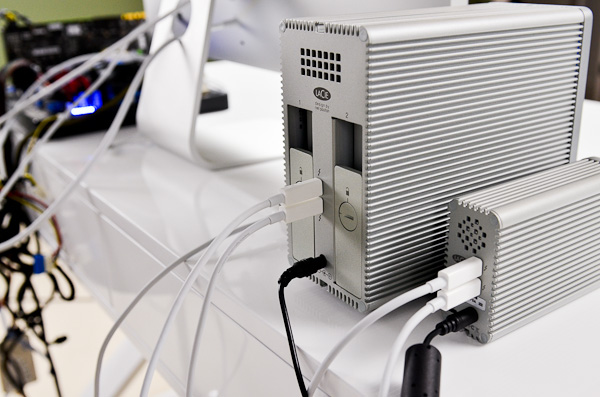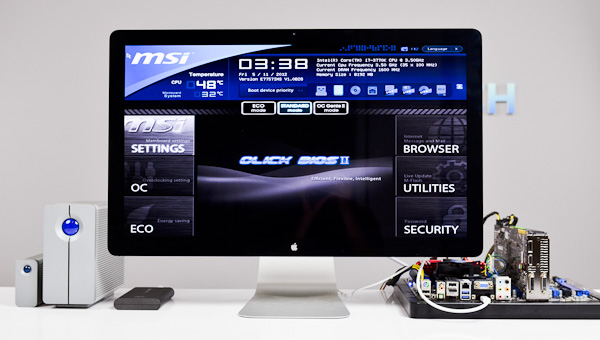A First Look at Thunderbolt on Windows with MSI's Z77A-GD80
by Anand Lal Shimpi on May 11, 2012 1:32 PM EST- Posted in
- Motherboards
- CPUs
- Intel
- MSI
- Thunderbolt
The Storage Devices & Performance
Other than Apple's Thunderbolt Display, every other TB device we've tested has been some sort of storage device. In my lab I've got Promise's Pegasus R6, LaCie's 2big and Little Big Disk (SSD), Seagate's GoFlex Thunderbolt adapter and Elgato's Thunderbolt SSD. With the exception of the Pegasus R6, which currently lacks Windows drivers, all of the storage devices I tested worked with MSI's Z77A-GD80 under Windows. Although there are workarounds for getting the Pegasus up and running under Windows, I encountered a number of hangs and general system unhappiness whenever I tried them on this platform. I suspect this has something to do with why Promise has yet to officially release Windows drivers for the Pegasus.
The rest of the storage devices, as you would expect, just worked. I didn't need to install any drivers as all of their internal controllers had native support under Windows 7. Again, I couldn't hot plug any of these devices once Windows was running - all of them had to be present at boot.
Just as I've seen under OS X, with complex Thunderbolt chains you'll sometimes have a device that hangs in the chain and prevents some or all TB devices from working. I did encounter this behavior more frequently under Windows than I did under OS X. Keep in mind that every single Thunderbolt device on the market today was pretty much developed and tested against Macs, it's going to be a little while before we get perfect behavior under Windows. We don't even have perfect behavior under OS X yet either. My hope is that as more platforms ship with Thunderbolt support, and as we get more Thunderbolt devices, compatibility and behavior validation will both improve. I've also heard that the early Thunderbolt controllers were more finicky than Cactus Ridge, so it's possible that newer TB devices that come out this year will just inherently be better behaved. This is purely hearsay however, I don't have any hard evidence to back it up.
Update: Intel tells us that an updated Pegasus driver is in the works that will address the issues we've seen. Other finicky behavior is also expected to be addressed through the Thunderbolt on Windows certification process.
Since I couldn't get the Pegasus working, I had to resort to combining a bunch of my other Thunderbolt storage devices to measure performance. I created a chain combining LaCie's 2big, the SSD Little Big Disk and Elgato's Thunderbolt SSD along with Apple's Thunderbolt Display. I ran a 128KB sequential read test at a queue depth of 32 across all of the drives, while pushing the Thunderbolt Display at its native 2560 x 1440 resolution:
The best I ever got under OS X was 8Gbps using four SandForce SSDs in the Promise Pegasus. At 7Gbps using a far less elegant setup, this isn't bad at all. Keep in mind that while we're reading at 7Gbps, the GD80 was also using around 7Gbps of bandwidth to drive the Thunderbolt Display at 2560 x 1440. Total available bandwidth for a single-port Thunderbolt device is 20Gbps bi-directional (40Gbps total), so there's still additional headroom available.
Moving Forward
MSI's Z77A-GD80 finally brings Thunderbolt to Windows desktops. With a few exceptions, the experience is quite similar to OS X. The major differences are that some devices clearly need more compatibility testing with these new platforms, and that you can't hot plug Thunderbolt devices under Windows. The former is solvable given additional time, while the latter can be more annoying in the long run if a workaround isn't found. For a single, high-speed storage device under Windows, USB 3.0 is going to be the simplest route. It's only when you want to start pushing even more bandwidth and/or add a display into the mix that Thunderbolt becomes your only solution.
Thunderbolt's functionality otherwise looks very similar under Windows as it does under OS X. The interface doesn't require any specific drivers and in the best conditions it just works. Thunderbolt's behavior remains quite finicky however, even more so under Windows. You'll want to wait for either the next generation of Thunderbolt devices or for the current device vendors to get some more time validating their Thunderbolt products on Windows platforms. Given that the first Thunderbolt equipped PC motherboards haven't even shipped yet, you've got some time.
Update: Intel has informed us that we will see updated drivers for Windows certified Thunderbolt devices that will enable hot plugging under Windows. Intel further informed us that MSI's board has not yet made it through the certification process and a lot of these teething issues will hopefully be addressed by then.
For much of the past year I've been calling for cheaper Thunderbolt storage devices, but with the arrival of Thunderbolt on Windows I'll modify my plea: we need more Thunderbolt display devices as well. As the desktop PC evolves, it would be nice to have only a single cable running from your PC to a Thunderbolt equipped display that acts as the IO hub for all of your peripherals. I'm thinking of something like Apple's Thunderbolt Display, but even heavier on the expansion side and with OS-independent display controls.













98 Comments
View All Comments
sphigel - Friday, May 11, 2012 - link
"does anyone else find this whole "Military Grade" thing that has been showing up on motherboards lately to be one of the most embarassingly cheesy marketing gimmicks ever?"It's been around for at least 10 years that I know of but, yes, it is very cheesy.
A5 - Friday, May 11, 2012 - link
Military/defense grade is a real thing when dealing with component rating, though. It makes absolutely zero difference (besides the cost) on consumer-grade stuff, but it is a different set of specifications.jabber - Saturday, May 12, 2012 - link
Well if there were real 'military grade' they would cost $5000 each as you'd have £4900 worth of 'recertification costs' over the standard OEM issue the defence contractor buys in and then stamps 'military grade'.StormyParis - Friday, May 11, 2012 - link
It's nice to see CPU usage... 20% seems high, but I guess for high throughput it's bearable, but what CPU was in your setup ?Did you run into any compatibility problems. I'm still having those with USB, both 2 and 3.. which is very disappointing .
Death666Angel - Monday, May 14, 2012 - link
He said it in the Youtube video: Core i7 3770K. :-)Stanly.ok - Friday, May 11, 2012 - link
"pushing the Thunderbolt Display at its native 2560 x 1600 resolution""drive the Thunderbolt Display at 2560 x 1600"
looks like you miss 30" Cinema Display a lot ((=
coder543 - Friday, May 11, 2012 - link
This review was really unfair in my opinion. This is one of the first reviews of a non-Apple usage of Thunderbolt, and we don't even try Linux on it? You spent pages reiterating over and over and over about how Windows doesn't support hot plugging of those devices.And you didn't see what Ubuntu (or Fedora, or whatever else) did when hotplugging? Come on.
Sincerely,
slightly frustrated at the complete absence of Linux on Anandtech.
Metaluna - Friday, May 11, 2012 - link
Yeah, this is one of the problems with Thunderbolt that doesn't get a lot of coverage, though kudos to Anand for touching on it in this article.The problem I'm referring to is that TB just pushes the driver availability problem out to the external device, which is particularly problematic for storage devices. Want to take that nice TB external drive and move it between OSX, Windows, Linux, FreeBSD, etc? Well, now you not only have to make sure all those machines have a TB port and a compatible filesystem, you also have to make sure they all have a driver for whatever controller chip the enclosure has in it. With USB, eSATA, SAS etc, each of those machines can just have whatever controller works best for that OS.
Zoomer - Friday, May 11, 2012 - link
It's a PCIE bridge chip on the phy layer, so it should be transparent to the OS as mentioned.The driver issue would be the same as if the external device was plugged into an internal PCIE slot.
Klimax - Saturday, May 12, 2012 - link
One thing: Windows support hotplugging(it doesn't care what type of device it is in general), but drivers have to support it too and if they don't provide proper callbacks to I/O manager then hotplug cannot work as IOM has no way to inform driver about changes.